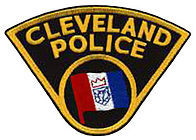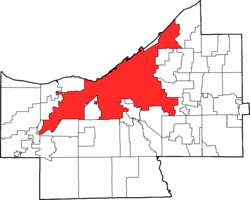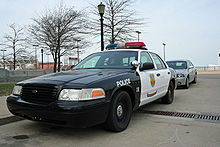- Cleveland Division of Police
-
This article is about the Cleveland, Ohio police force. For the English police force, see Cleveland Police.
Cleveland Division of Police Common name Cleveland Police Department Patch of the Cleveland Division of Police. Agency overview Formed 1868 Legal personality Governmental: Government agency Jurisdictional structure Operations jurisdiction* City of Cleveland in the state of Ohio, United States Jurisdiction of the Cleveland Division of Police Size 213.4 km² Population 478,000 Governing body Cleveland Department Of Public Safety General nature Operational structure Officers 1,600+ Elected officer responsible Martin L. Flask, Director Agency executive Michael McGrath, Chief of Police Operations 4- Administrative Operations
- Field Operations
- Special Operations
- Homeland Security
Facilities Districts 5 Website Division of Police Footnotes * Divisional agency: Division of the country, over which the agency has usual operational jurisdiction. The Cleveland Division of Police is the law enforcement agency responsible for the city of Cleveland, Ohio. Since 2005, Michael McGrath has been the chief of police.
Contents
History
Pre-World War II
See also: Elliot NessFrom the early 1900s to the start of World War II, the department concentrated on managing the city's rapid growth. Cleveland was rapidly growing, even through the Great Depression, with the population increasing from 380,000 in 1900, to more than 830,000 by the 1920s.[1] The police department grew with the city, growing from less than 400 officers in 1900, to more than 1,300 by 1920. When legendary Prohibition-era crimefighter Elliot Ness became director of public safety in 1935, he abolished the existing system of precincts and reorganized the city into police districts, with each commanded by a captain.[1] Ness's system is still in use today. Under Ness, the police department experimented with new technologies and procedures, gaining a reputation as one of the most progressive and efficient departments in the nation.[1]
Post-World War II
While the population of the city remained stable through the 1940s and 1950s, the police department continued to grow, with more than 2,000 officers by 1960. However, the 1960s saw relations between the department and the city's growing Black community begin to deteriorate. In 1966, even though Cleveland was over 1/3 Black, only 165 of Cleveland's 2,200 police officers were Black, adding to the distrust between the Black community and the Police Department[2] especially in events leading up to the Hough Riots and Glenville Shootout.
By the 1970s, the department, like the rest of the city government, was suffering from Cleveland's failing economy. Aging equipment could not be replaced, and the department saw its numbers drop by more than 700 by the end of the decade. This, along with rising crime rates left the police department with a reputation as a disorganized and demoralized force that would take decades to lose.[1] Further aggravating the situation, The City of Cleveland was found guilty of discriminating against minorities in hiring, promoting, and recruiting government officials, specifically police officers, by a federal court in 1977.[1] As a result of this judgement, the department was forced to place an emphasis on rebuilding community relations and recruiting minorities. By 1992, the number of police officers increased by more than 300 officers to 1,700, of whom 26% were black. During the administration of Michael White the department began to focus on community policing and rebuilding the damaged relationship between the department and the community. Nonetheless, during the White administration the role of Police Chief was "a revolving door of chiefs".[1]
Under the Jane L. Campbell administration of 2002-06, the Cleveland Police Department laid off more than 200 officers, several units including the Police Aviation Unit were grounded, Ports and Harbor were disbanded, and even the CPD Mounted (Horse) unit were disbanded. The department was again seen as a demoralized force during the Campbell administration.[1]
Present
Under current mayor Frank Jackson, the Cleveland Police saw a rise in morale due to changes effected by Jackson and there has been a class of new police officers graduated. Mayor Jackson has restored the Cleveland Police Aviation Unit and there are plans to expand it duties to help patrol over all of Cleveland and its suburbs. Mayor Jackson has revamped the Police Districts from 6 to 5 and has ordered police to be aggressive in the fight against crime. The CPD mounted unit has been restored and those mounted officers patrol the downtown Cleveland area. The ports and harbor units will also be restored. Mayor Jackson has had one Chief of Police during his administration, as opposed to other administrations. The Cleveland Police are also investigating the possibility of remodeling certain aspects of the department after the NYPD, including initia9lizing a Compstat system.
The department also helps their suburban Cleveland counterparts in solving crimes. Cleveland Police have technology that can look at surveillance tapes from bank robberies, this technology is a joint venture between the Cleveland Police and NASA Glenn-Lewis Research Center. Many bank robberies in Cleveland and its suburbs have been cracked with this technology. Cleveland Police have recently formed a financial crimes unit.
Notable/Historic cases involving the CPD
- 1908 - Collinwood School Fire.
- 1935 - Torso Murders, in Cleveland's Kinsman neighborhood. CPD found the torsos and decapited bodied in area in Cleveland's Woodland, Kinsman, and East 93rd Street.
- 1954 - Cleveland Police assisted Bay Village, Ohio Police with the Dr. Sam Sheppard Case.
- 1963 - Terry v. Ohio (case decided 1968) - U.S. Supreme Court case establishing Constitutionality of police stop-and-frisk procedures
- 1971 - Cleveland Police arrested Actress/Activist Jane Fonda at Cleveland Hopkins Airport.
- 1977 - Death of Danny Greene
- 1985 - Cleveland Police SWAT Team assaults a hijacked - Pan American World Airways airliner and subdues the hostage taker. No lives lost.
- 2003 - Case Western University shooting
- 2007 - Shooting at Cleveland Successtech High School. Shooter is the only fatality
- 2009 - Cleveland Strangler Case, 11 dead bodies were found and 6 have been identified as of November 2009.
Fallen Officers
Since 1853, The Cleveland Division of Police has lost 106 officers in the line of duty.[3]
Organization
Administrative Operations
- Provides services that enable the other programs to effectively respond to service calls. It provides security services; warrant, subpoena and property processing; radio and telephone communications; inspection of police services; and management of information and human resources. Additional functions include the reporting and recording of crimes and incidents and personnel development.
Field Operations
- Bureau of Traffic
- As part of Field Operations, the Bureau of Traffic provides traffic and crowd control at major events, investigates serious traffic accidents and ensures the safety of school children walking to and from school.
- Downtown Services Unit (D.S.U)
- In May 2008 the D.S.U. was created to offset the closing of the old Third District while still providing a police presence in the downtown area. In addition to regular patrol the D.S.U. is involved in policing special events, the Warehouse District, as well as numerous undercover enforcement operations.
- D.A.R.E. programs
- Community Relations
- Auxiliary Police
- Patrol
- District Support
- District support sections assist uniformed patrols through the investigation of major offenses, concentrated action on specific complaints, and crime pattern analysis.
Special Operations
- S.W.A.T (founded in 1979)
- Aviation Unit (Founded in 1990)
- Does patrols for the city owned Cleveland Hopkins International Airport
- Ports and Harbor Unit (Founded 1939)
- Mounted Unit
- Investigations Division
- Detective Bureaus
- Arson
- Auto Theft
- Fraud
- Narcotics
- Robbery/Homicide
- Sex Crimes/Special Victims
- Youth Domestic Violence
- Detective Bureaus
- Technical Support Division
- Photography Lab Services
- Forensics and Crime Scene Investigation/Analysis
Rank Structure and Insignia
Title Insignia Chief Deputy Chief Commander Captain Lieutenant Sergeant Police Officer Demographics
- Male: 83%
- Female: 17%
- White: 67%
- African-American/Black: 27%
- Other: 6%[4]
Resources
Cleveland has used black and white Ford Crown Victoria interceptors for the past 25 years. However, Cleveland's continued use of the Crown Victoria is in question due to Ford's ending of the Crown Victoria in 2011, with the Chevrolet Impala or the Dodge Charger being viewed as replacements.
Controversy
Hough Riots
The Hough Riots were race riots in the predominantly African American community of Hough that took place over a six-night period from July 18 to July 23, 1966, after a series of racially-motivated confrontations outside of a neighborhood bar.[5] Racial tension was high between Cleveland's police and its African American community to begin with, and played a crucial role in further escalating the situation.[5] During the riots, four African Americans were killed and 30 people were critically injured. In addition, there were 275 arrests, while more than 240 fires were reported.[5]
Glenville Shootout
The Glenville Shootout was the culmination of a series of violent incidents that occurred in the Glenville section of Cleveland from July 23 to July 28, 1968.[6] The main incident began on the evening of July 23, 1968 in the eastern section of the Glenville neighborhood. Cleveland police officers were watching Fred Ahmed Evans and his radical militant group, who were suspected of purchasing illegal weapons.[6] It was not clear who shot first, but Evans and the police exchanged gunfire. The shootout attracted a large crowd that was described as "mostly black, young, and 'hostile'".[6] When it became clear that the department was ill-equipped to handle the situation, then-mayor Carl B. Stokes called in the National Guard. The violent acts resulted in the deaths of seven people, and injuries of fifteen others.[6]
The Hongisto feud
As then-mayor-elect, Dennis Kucinich appointed former San Francisco, California Sheriff Richard D. Hongisto as chief of police in 1977, a decision he would later come to regret.[7] Hongisto became immensely popular in Cleveland, especially with the city's ethnic Eastern European community. The chief was also popular with the media, especially after Hongisto saved a person from a snow bank during a 1978 snowstorm.[8] However, on March 23, Kucinich publicly suspended Hongisto for refusing to accept civilian control. Hongisto asserted that Kucinich interfered with the operation of the department.[9] Specifically, he stated that Kucinich's executive secretary Bob Weissman had pressured him to "punish" Kucinich opponents on the City Council and to reward police jobs to Kucinich supporters with "questionable ethics." In turn, Kucinich charged Hongisto with insubordination.[9]
In a press conference televised on Good Friday 1978, Kucinich gave Hongisto 24 hours to back up his charges. Then the mayor fired the chief in front of the live television cameras.[9] The controversial firing would be one of the underlying causes of Kucinich's near-removal from office.
See also
References
- ^ a b c d e f g "The Encyclopedia of Cleveland History". http://ech.cwru.edu/ech-cgi/article.pl?id=CPD1.
- ^ "Hough Riots". http://www.ohiohistorycentral.org/entry.php?rec=1600., Ohio History Central
- ^ "The Officer Down Memorial Page". http://www.odmp.org/agency/735-cleveland-police-department-ohio. Retrieved 08-09-2008.
- ^ Law Enforcement Management and Administrative Statistics, 2000: Data for Individual State and Local Agencies with 100 or More Officers
- ^ a b c Walter Johnson. "The Night They burned Old Hough". http://www.nhlink.net/ClevelandNeighborhoods/hough/Eyewitness2.htm. Retrieved 08-08-31.
- ^ a b c d The Encyclopedia Of Cleveland History by Cleveland Bicentennial Commission (Cleveland, Ohio), David D. Van Tassel (Editor), and John J. Grabowski (Editor) ISBN 0-253-33056-4
- ^ Cleveland: Prodigy of the Western Reserve by George E. Condon ISBN B0006DX6QQ
- ^ The Crisis of Growth Politics: Cleveland, Kucinich, and the Challenge of Urban Populism by Todd Swanstrom ISBN 0-87722-366-1
- ^ a b c The Plain Dealer, August 1, 1999. Our Century: 'Boy Mayor' Leads Battle Into Default by Fred McGunagle.
External links
City of Cleveland City Council · Historic Places · History · Timeline · Mayors · Media · People · Police · Public schools · Sports · Tallest buildings Neighborhoods Brooklyn Centre · Buckeye-Shaker · Central · Clark-Fulton · Corlett · Cudell · Detroit-Shoreway · Downtown · Edgewater · Euclid-Green · Goodrich-Kirtland Park · Fairfax · Forest Hills · Glenville · Hough · Industrial Valley · Jefferson · Kamm's Corners · Kinsman · Lee-Miles · Mt. Pleasant · North Broadway · North Collinwood · Ohio City · Old Brooklyn · Puritas-Longmead · Riverside · South Broadway · South Collinwood · St. Clair-Superior · Stockyards · Tremont · Union-Miles Park · University · West Boulevard · Woodland HillsCategories:- Law enforcement agencies of Ohio
- 1868 establishments
- Cleveland Division of Police
- Government of Cleveland, Ohio
- Municipal police departments of Ohio
Wikimedia Foundation. 2010.



